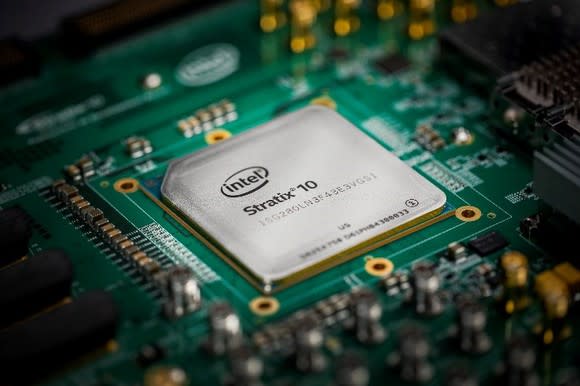Can Intel Dominate This Market by Overcoming This Smaller Rival?
Intel (NASDAQ: INTC) placed a big bet on the future of programmable chips by spending $16.7 billion to acquire Altera a couple of years ago. Chipzilla believed that Altera's field-programmable gate arrays (FPGA) would play a critical role in powering artificial intelligence (AI) solutions given their customizable nature.
The good news is that Intel has made good progress in this space, as evident from the company's third-quarter earnings report released in late October. But is the chip giant doing enough to make a bigger dent by overcoming market leader Xilinx (NASDAQ: XLNX)?

Image Source: Intel.
Charting Intel's FPGA progress
Intel's revenue from its programmable solutions group (which houses the FPGA division) increased 10% year over year during the third quarter to $469 million. This is not even 3% of Intel's total revenue, but the potential is huge given the increasing usage of FPGA chips for AI applications.
In fact, FPGA chips are already finding traction in fast-growing areas such as automotive and data centers. This isn't surprising as the flexible architecture and the low power consumption of FPGA chips allow developers to program these modules to perform tasks that couldn't have been executed by fixed architecture chips such as GPUs (graphics processing units) or CPUs (central processing units).
For instance, Audi is using Intel's FPGAs to enable autonomous driving in next year's A8 sedan, while automotive components manufacturer Denso has deployed Intel's technology to power a stereo vision system. This opens up a big opportunity for Intel as automakers are increasingly using FPGAs in their vehicles to power a host of features such as adaptive cruise control, collision avoidance, and driver assistance.
Moreover, Intel's FPGAs will come in handy in its own autonomous car development project, which has started gaining impressive traction. The benefits of this chip platform could help Chipzilla steal a march over rival NVIDIA, which primarily relies on the computing power of its GPUs to power AI systems in self-driving cars.
But cars aren't the only catalyst for Intel's FPGA business. The ability of these chips to quickly solve unique problems because of a flexible architecture and low power consumption makes them ideal for use in AI applications such as data centers. As it stands, Intel's FPGAs are already being used by data centers to power deep learning platforms in the cloud.
For instance, Microsoft is using Chipzilla's Stratix FPGAs in Project Brainwave, which is an accelerated deep learning platform based on FPGAs. Microsoft plans to provide real-time AI in the cloud by processing and transmitting data as fast as possible, and this is made possible by Intel's FPGAs.
But Microsoft isn't the only one using Intel's FPGAs to build the AI-enabled cloud. Alibaba recently announced that it is using these chips to power its Acceleration-as-a-Service offering in the Alibaba Cloud. This service allows Alibaba customers to accelerate the development and deployment of compute-intensive tasks such as AI inferencing and video streaming through a pay-as-you-go model that doesn't require any upfront investments.
Therefore, Intel seems to be on track to grab a bigger piece of the FPGA market that could be worth $14 billion by 2024, as per Grand View Research. But this is easier said than done as Intel will have to overcome the technology lead of Xilinx.
A look at the competition
Xilinx is Intel's biggest challenge in the FPGA space, thanks to the former's technology lead that has allowed it to capture almost 60% of this market. Looking ahead, Xilinx believes that its FPGA market share could go up to a range of 60%-65% by 2021.
Xilinx's ambitious forecast doesn't seem out of place as it has started developing FPGA chips on a more efficient 7nm node, while Intel is now testing the 10nm platform. This could extend Xilinx's existing 18-month technology lead over Intel in FPGAs, as chips based on a smaller footprint consume less power and reduce costs.
But Chipzilla can fight back thanks to an integrated solution it is developing to tap the server market. Intel recently revealed that it is going to integrate FPGAs with its x86 server CPUs. This hybrid solution is expected to accelerate the performance of its server CPUs, with the FPGA component taking on workloads that the CPU couldn't have performed efficiently.
Additionally, Intel is also planning to launch a discrete FPGA chip that can be bolted on to existing server chips. Both these variants are expected to hit the market next year, and it won't be surprising if they boost Intel's share of the FPGA chip market given its monopoly in this market. In fact, Intel controls almost all of the data center chip market, so it can easily push its chips into existing sales channels and dent Xilinx's business.
Therefore, FPGAs can become big business for Intel in the long run given the potential size of this market. More importantly, even if Intel holds on to its current FPGA market share of 42%, this segment's revenue could grow to almost $6 billion by 2024 (based on Grand View Research's forecast of the total market size).
But Intel looks well-placed to grow its clout in FPGAs thanks to recent contract wins and dominance in the cloud server market, putting the company on track to generate more revenue.
More From The Motley Fool
6 Years Later, 6 Charts That Show How Far Apple, Inc. Has Come Since Steve Jobs' Passing
Why You're Smart to Buy Shopify Inc. (US) -- Despite Citron's Report
Teresa Kersten is an employee of LinkedIn and is a member of The Motley Fool's board of directors. LinkedIn is owned by Microsoft. Harsh Chauhan has no position in any of the stocks mentioned. The Motley Fool owns shares of and recommends Nvidia. The Motley Fool recommends Intel. The Motley Fool has a disclosure policy.
